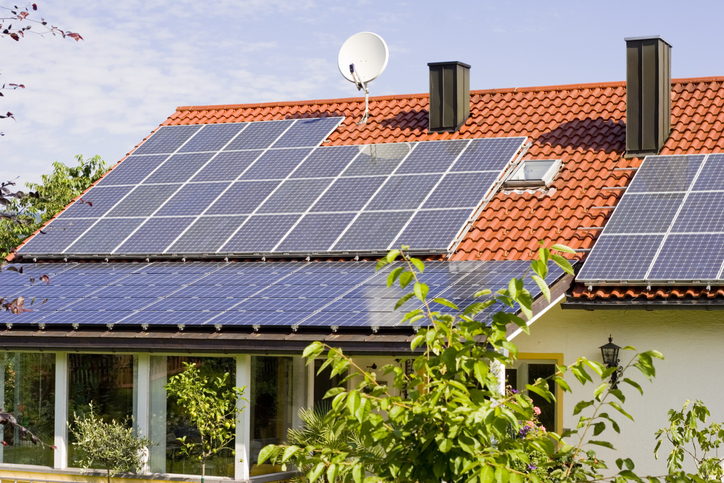Solar technology is pretty complex from a scientific perspective, but that doesn’t mean the average person can’t understand the concepts behind it. In fact, if you plan to take advantage of the tax credits by installing a residential solar panel system it’s in your best interest to know how the technology works before making the investment.
By the end of this easy-to-understand overview you’ll have a much better idea of how solar panels work to produce electricity at home and help lower your energy bill. And if you still have questions, you can contact the Major Energy team to learn more about using a solar system.
Solar Panel Equipment: The Basics
Let’s start by taking a look at the equipment that’s needed to power a solar panel system, also known as a photovoltaic (PV) system.
Solar Panels and Racks
Solar panels are the part of a system that most people are familiar with. You can see the rectangular or square panels on the roof of a home or less commonly on the ground. Racks are needed to hold the solar panels and angle them for optimal sun exposure.
Today, there are a lot of options for solar panels with different performance specs, but they all work in the same general way. Solar panels made of silicon will either be monocrystalline (most efficient) or polycrystalline (more affordable). Photovoltaic cells contained in the solar panels convert sunlight into direct current (DC) power.
Inverter
An inverter is needed to convert the DC power that’s generated by the solar panels into alternating current (AC) power that can be used by the home. There are three types of inverters:
- String Inverter – This is a straightforward option that connects all the solar panels as one unit to your electrical panel. This is the least expensive option, but it comes at the sacrifice of less optimization.
- Microinverter – With a microinverter each solar panel is connected to the electrical panel separately. It’s more expensive than a string inverter, but it’s better for optimizing energy production.
- Power Optimizer/Centralized Inverter – A power optimizer blends the functionality of a string inverter and a microinverter. It’s connected to each individual solar panel, however, it isn’t actually an inverter. The power optimizer sends conditioned solar power to a centralized inverter where it’s converted to AC power.
Battery
If you’re the type of energy user that wants to be as self-sufficient as possible, a battery should be part of your solar panel system. You’ll need a battery to store power for later use when the sun goes down or the weather is bad. If you have a net metering program you may not need to have a battery since you’re connected to the electric grid that can be used as a backup power supply or storage for excess solar energy.
Charge Controller
A charge controller is connected to the solar panels to control the voltage and ensure there isn’t overcharging. You can choose between simple 1-stage, 2-stage, pulse width modulation (PWM) and maximum power point tracking (MPPT) charge controllers.
Performance Monitoring System
It can also help to have a performance monitoring system connected to the PV system. A performance monitoring system helps you track solar power generation and optimize how you use solar energy. Performance monitoring systems can be installed at the panels (on-site monitoring) or be remote monitors that work through the cloud.
How a Solar Panel System is Put Together
All of the pieces of a solar panel system work together to create usable power out of thin air. Here’s how everything flows together in a basic PV system so that energy flows to your home.
Solar Panels Are Mounted to a Surface With Racks
Unless you are constructing a new home with building-integrated PV, your solar panels will need to be mounted to a solid surface or the ground using racks. If the panels are ground-level the racks may have a tracking mechanism that moves the panels for maximum sun exposure throughout the day.
Solar cells in the panels absorb solar radiation from the sunlight and convert it into an electrical current. This is what’s called the photovoltaic effect. Plates and wires within the panel capture the electrical current and turn it into direct current power.
DC Power From Panels Goes to the Charge Controller
The charge controller will be hooked up to the panels with positive and negative leads. The DC power voltage and amperage is regulated within the charger controller before moving on.
Regulated Power Flows to the Inverter or Battery
Once the DC power from the panels is regulated by the charge controller it passes on to the battery for storage (if one is installed) or the inverter.
DC Power is Converted to AC Power at the Inverter
Although the power is regulated, it still isn’t usable yet. When the solar-generated power reaches the inverter it’s converted into AC power that can be used in the home.
AC Power is Sent to the Electrical Panel
Now that the power is correctly charged, it is sent to the electrical panel where it can be distributed throughout the home on different circuits.
AC Power is Used by Appliances and Devices
Last but not least, the electricity reaches the appliances and devices that are plugged in and turned on.
All of this coordination happens in fractions of a second behind the scenes. Once everything is installed you shouldn’t notice any difference in how you use the power you generate from the sun.
Not ready to go off the grid just yet? Major Energy has you covered with fixed-rate plans that provide a reliable power supply and make energy expenses more predictable. Check to see which Major Energy plans are offered in your area.
